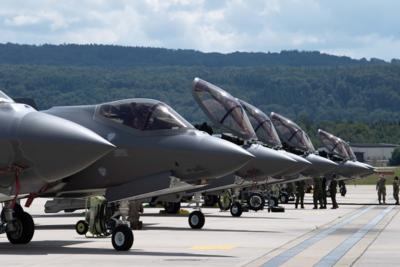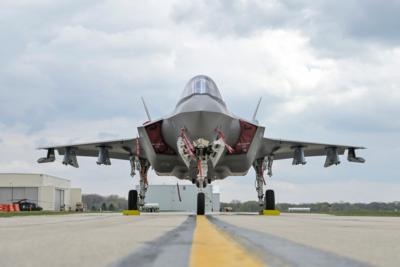Wed, Jul 17, 2024
Temporarily Reduced Functionality is an Appropriate Trade-Off to Get Deliveries Started Again
Lockheed Martin's backlog of F-35 Lightning IIs will soon be cleared to leave the nest and head to their new homes now that a 'truncated' version of their Technology Refresh 3 package is approved.

As seems to be the norm for Lockheed Martin's expensive fighter, development is behind on its timelines, with the TR-3 suite facing issues to the point that deliveries have been paused altogether. The DOD didn't want to accept F-35's without the TR-3 upgrade, which has effectively paused all deliveries until the Joint Program Office could find a build that works. Now, the JPO has approved the delivery of aircraft with a truncated version of its TR-3 software on board, which will provide a modicum of Block 4 F-35 functionality with the expectation it will be replaced with more fleshed-out versions in the future. The TR-3 package of displays, processors, and software underpin the F-35's Block 4 upgrade, providing the needed digital 'oomph' to make the most of its new hardware. Earlier this year, Lockheed had said that they'd have somewhere from 100 to 120 jets in long-term storage by the middle of 2024, including fighters destined for US military branches and F-35 partners abroad. If all goes well with
filing the paperwork, Lockheed could start delivering their aircraft immediately, which would be great news for Lightning operators around the world.
It's not too surprising that the military is embracing the same model as everyone in the commercial sphere: Ship first, and update later. As recently as May, there was hesitation about giving TR-3 the go-ahead, since reports had mentioned some user issues with the then-current form of the software. Having to reboot multiple times in the course of a flight doesn't instill much confidence in a fighter, at least. But Lieutenant General Michael J. Schmidt, F-35 program executive officer, is optimistic that they can get a version shipped that will strike a balance between being reliable and combat effective today while retaining room to grow. His approval is the thing that got the gears moving again on a truncated TR-3. Schmidt's blessing will mean a lot for the program, allowing operators to breathe easy with a revised software suite.

The important part for the DOD is that new production aircraft will have TR-3 and Block 4 installed from the start, precluding an overhaul in the future. It's a passable stopgap for now, giving users enough combat capability with the promise of better next-generation capabilities to come. It's no wonder Block 4 has given them some trouble: Originally, it was slated to add 66 new capabilities to the F-35, but improvements to tech led planners to keep adding to the pile until today's iteration boasts about 80 in all. That's led some in the JPO to hint that a reimagined version of Block 4 could be in the cards, a suite that improves on the F-35's electronic warfare, communications, navigation, armament, and identification systems.
More News
19-Year-Old Pilot Was Attempting to Fly Solo to All Seven Continents On his journey to become the first pilot to land solo on all seven continents, 19-year-old Ethan Guo has hit a >[...]
From 2017 (YouTube Edition): A Quality LSA For Well Under $100k… Aeroprakt unveiled its new LSA at the Deland Sport Aviation Showcase in November. Dennis Long, U.S. Importer>[...]
Hazardous Weather Information Summary of significant meteorological information (SIGMET/WS), convective significant meteorological information (convective SIGMET/WST), urgent pilot>[...]
Aero Linx: Historic Aircraft Association (HAA) The Historic Aircraft Association (HAA) was founded in 1979 with the aim of furthering the safe flying of historic aircraft in the UK>[...]
"We would like to remember Liam not just for the way he left this world, but for how he lived in it... Liam was fearless, not necessarily because he wasn't afraid but because he re>[...]
 TikToker Arrested After Landing His C182 in Antarctica
TikToker Arrested After Landing His C182 in Antarctica Classic Aero-TV: Versatile AND Practical - The All-Seeing Aeroprakt A-22 LSA
Classic Aero-TV: Versatile AND Practical - The All-Seeing Aeroprakt A-22 LSA ANN's Daily Aero-Term (06.27.25): Hazardous Weather Information
ANN's Daily Aero-Term (06.27.25): Hazardous Weather Information ANN's Daily Aero-Linx (06.27.25)
ANN's Daily Aero-Linx (06.27.25) Aero-News: Quote of the Day (06.27.25)
Aero-News: Quote of the Day (06.27.25)




